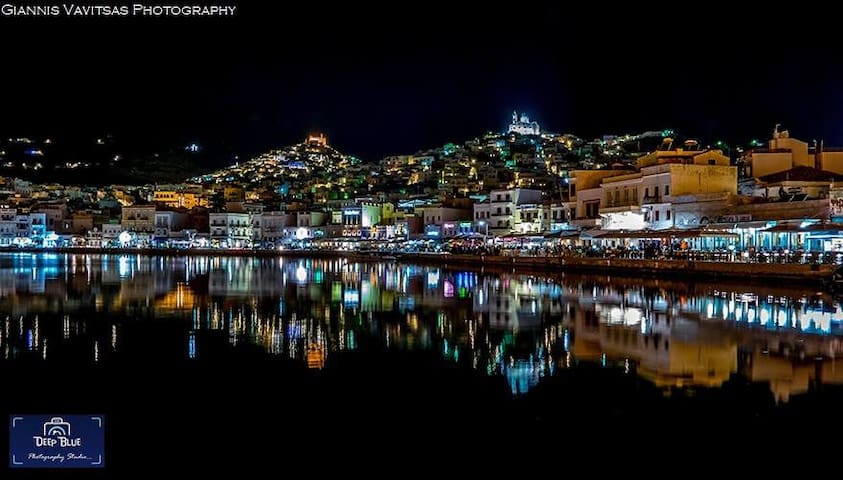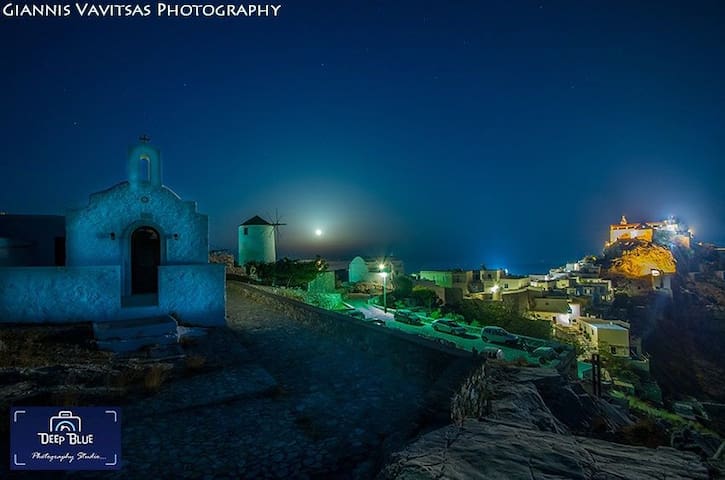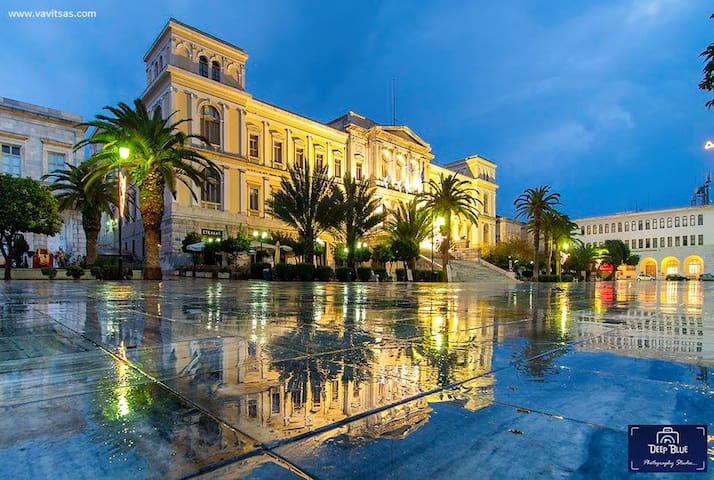Places to visit
The capital of Syros as well as of the insular complex of the Cyclades exudes an aura of neoclassical romance harmoniously combining elements from ancient Greece and Western Europe.
Ermoupoli
The capital of Syros as well as of the insular complex of the Cyclades exudes an aura of neoclassical romance harmoniously combining elements from ancient Greece and Western Europe.
Ano Syros was founded in 1200 by the Venetians and continued to be inhabited throughout the course of history while maintaining its Catholic and medieval character. A city characterized by countless steps that pass by the white houses and arches at the edge of the hill leading to the top of the village where the Catholic Cathedral of Saint George is situated.
The town was created gradually, amphitheatrically on the rocks like a natural fortress so as to keep its residents safe from several attacks while the exterior walls of all houses formed a natural fort protecting the locals from the raids. The narrow cobblestone streets gave residents the opportunity to hide from the various pirate attacks while the wooden doors in the entrances of Portara, Epano & Kato Terma, Skalakia and Sabastias completely sealed the city from any invasion.
Home of the philosopher Pherecydes, Ano Syros was and remains a city with distinct character and identity, a city telling a story through its monuments and historic buildings, through the Historical Archive of Ano Syros, the Exhibition of Traditional Professions and other points of interest such as the bust of the national hero, Don Ioanni Dalezio and the spring of Agios Athanasios. A city with a catholic identity unfolding through the Jesuits and Capuchins monasteries, the Church of Virgin Mary of Karmilou and other Catholic churches.
By 2010 Ano Syros was the capital of the municipality while today constitutes the island’s historic base offering a plethora of tourist facilities, restaurants, taverns, cultural landmarks and attractions including the old Castle gate leading to the old town, the bust of the great traditional singer Markos Vamvakaris and the Town Hall. Ano Syros is just 3.5 km away from the port of Ermoupolis, a distance worth covering on foot.
94 Einheimische empfehlen
Ano Syros
Ano Syros was founded in 1200 by the Venetians and continued to be inhabited throughout the course of history while maintaining its Catholic and medieval character. A city characterized by countless steps that pass by the white houses and arches at the edge of the hill leading to the top of the village where the Catholic Cathedral of Saint George is situated.
The town was created gradually, amphitheatrically on the rocks like a natural fortress so as to keep its residents safe from several attacks while the exterior walls of all houses formed a natural fort protecting the locals from the raids. The narrow cobblestone streets gave residents the opportunity to hide from the various pirate attacks while the wooden doors in the entrances of Portara, Epano & Kato Terma, Skalakia and Sabastias completely sealed the city from any invasion.
Home of the philosopher Pherecydes, Ano Syros was and remains a city with distinct character and identity, a city telling a story through its monuments and historic buildings, through the Historical Archive of Ano Syros, the Exhibition of Traditional Professions and other points of interest such as the bust of the national hero, Don Ioanni Dalezio and the spring of Agios Athanasios. A city with a catholic identity unfolding through the Jesuits and Capuchins monasteries, the Church of Virgin Mary of Karmilou and other Catholic churches.
By 2010 Ano Syros was the capital of the municipality while today constitutes the island’s historic base offering a plethora of tourist facilities, restaurants, taverns, cultural landmarks and attractions including the old Castle gate leading to the old town, the bust of the great traditional singer Markos Vamvakaris and the Town Hall. Ano Syros is just 3.5 km away from the port of Ermoupolis, a distance worth covering on foot.
Sights
Miaouli square is the historic square of Syros featuring architectural marvels that blend into a dreamy landscape of the 19th century with buildings that testify the existence of a great civilization. It is worth visiting the Town Hall inspired from Ziller that has been giving a special character to the area since 1898 with its impressive staircase of 15.5 meters width, the club that houses the cultural center since 1863 and the historical archives of Syros in a building situated next to the Town Hall. Of course the square also features the statue of the admiral from the war of independence Andreas Miaoulis. After several other names that preceded such as square Othonos and Leotsakou the square was finally named in honor of the admiral. An impressive music stage with embossed drawings of Apollo and the muses transformed the space into the ultimate meeting point of the island. Today the square is the heart of the political, social and cultural life of the island and the ideal choice for walks and coffee breaks at the surrounding coffee shops.
17 Einheimische empfehlen
Miaouli-Platz
Miaouli square is the historic square of Syros featuring architectural marvels that blend into a dreamy landscape of the 19th century with buildings that testify the existence of a great civilization. It is worth visiting the Town Hall inspired from Ziller that has been giving a special character to the area since 1898 with its impressive staircase of 15.5 meters width, the club that houses the cultural center since 1863 and the historical archives of Syros in a building situated next to the Town Hall. Of course the square also features the statue of the admiral from the war of independence Andreas Miaoulis. After several other names that preceded such as square Othonos and Leotsakou the square was finally named in honor of the admiral. An impressive music stage with embossed drawings of Apollo and the muses transformed the space into the ultimate meeting point of the island. Today the square is the heart of the political, social and cultural life of the island and the ideal choice for walks and coffee breaks at the surrounding coffee shops.
The historic Theater Apollon is one of the major attractions of Syros and constitutes an emblem of the island’s cultural heritage. Created in 1864 by the Italian architect Pietro Sampo who was inspired by 4 stunning Italian standards including the Scala di Milano, the theater Apollon adorns the heart of the capital to this day. The Apollo Theater first opened its doors with an Italian theater troupe that among others performances staged the famous Italian opera La Traviata. Its architectural splendor though did not manage to prevent the major catastrophes that the theater suffered over the years. The Apollon theater was forced to close and to spend a long period of renovations and interventions with funding from the state, with the full support of GNTO and the artistic supervision of Dimitris Fortsas as well as of the architect Peter Pikionis until 2000. Today the theater hosts various artistic and cultural events such as the Festival of the Aegean, famous plays and world-class performances.
Cultural Events of Syros
The Apollon theater hosts some of the most important cultural events, operas and amazing theatrical works from local and international theatrical troupes. Theater enthusiasts can find information on upcoming performances and learn about reservations and tickets for plays and events they wish to attend through the theater’s calendar of events. The Apollon theater also houses the Theater Museum or else “the memory place” founded in 2002. The Museum hosts findings from local and other artists who played an important role in the history of this monumental theater, a theater being the ultimate alternative for entertainment and unrivaled amusement on the island.
Working Hours:
Everyday: 10:00 – 14:00 & 18:00 – 21:00 ( excluding events and rehearsals days )
74 Einheimische empfehlen
Θέατρο Απόλλων / Apollon Theater
The historic Theater Apollon is one of the major attractions of Syros and constitutes an emblem of the island’s cultural heritage. Created in 1864 by the Italian architect Pietro Sampo who was inspired by 4 stunning Italian standards including the Scala di Milano, the theater Apollon adorns the heart of the capital to this day. The Apollo Theater first opened its doors with an Italian theater troupe that among others performances staged the famous Italian opera La Traviata. Its architectural splendor though did not manage to prevent the major catastrophes that the theater suffered over the years. The Apollon theater was forced to close and to spend a long period of renovations and interventions with funding from the state, with the full support of GNTO and the artistic supervision of Dimitris Fortsas as well as of the architect Peter Pikionis until 2000. Today the theater hosts various artistic and cultural events such as the Festival of the Aegean, famous plays and world-class performances.
Cultural Events of Syros
The Apollon theater hosts some of the most important cultural events, operas and amazing theatrical works from local and international theatrical troupes. Theater enthusiasts can find information on upcoming performances and learn about reservations and tickets for plays and events they wish to attend through the theater’s calendar of events. The Apollon theater also houses the Theater Museum or else “the memory place” founded in 2002. The Museum hosts findings from local and other artists who played an important role in the history of this monumental theater, a theater being the ultimate alternative for entertainment and unrivaled amusement on the island.
Working Hours:
Everyday: 10:00 – 14:00 & 18:00 – 21:00 ( excluding events and rehearsals days )
Experiences
SEEKING TRACES OF ANCIENT CIVILIZATIONS IN SYROS
Syros is undoubtedly a blessed place, a place that, from your very first moments on the island, you feel how much it has been loved by locals and its newcomers. You see it everywhere when you look around, all around the island and you realize that every man’s creation in this place has been done with passion!
But the history of Syros is so long that it is lost in the depths time. The important archaeological sites of the island are irrefutable witnesses of that. Travel to these ancient places, making a journey back in time, wishing that this journey would be real!
On the northern side of the island, Chalandriani is probably of the smallest settlement on the island, but it is of great archaeological interest since it dates back to the Early Cycladic period (3,000 BC). In the small fertile plateau extending to the sea, excavations revealed a large Early Cycladic cemetery with more than 600 graves. At the point where you stand you feel a cool breeze caressing your face and as you lift your eyes, you realize that you are at a truly unique spot from where you can gaze at the sea and the neighboring islands of Tinos and Andros. You will get fascinated by thinking that thousands of years ago the area’s inhabitants were gazing at the very same view.
The excavations of the graves revealed rich gifts (jewels, vases, stone sandblasters, household utensils, compasses, weapons) that testify to the prosperity of the settlement. The clay utensils with the elaborate decoration, most of which depict rowing boats, as well as the famous Cycladic marble idols, stand out.
If you move west of Chalandriani following a narrow path and after a 45-minute walk, you will reach the Kastri high cliff and admire the homonymous fortified settlement. According to the findings on the ancient citadel, dating from 2300 to 2200 BC, pottery, stone-carving, miniature art and metalworking had been developed in the area.
A visit to the archaeological sites of Kastri – Chalandriani creates a strong desire to see some of the findings of the excavations, which are exhibited at the National Archaeological Museum (Athens), at the Goulandris Museum of Cycladic Art, but also at the Archaeological Museum of Hermoupolis. The Archaeological Museum is one of the oldest museums in Greece and it is housed in the imposing building of the Town Hall.
But before that you, can go even northern and reach Grammata beach. The easiest way is to go by boat. Hikers can choose to follow the footpath from Kambos to Apo Meria. It will take about an hour. When you get to the beach you can still see the sailors engraved inscriptions with wishes and prayers to the gods to continue safely their journey. They were found there, as the bay was once considered one of the safest spot of the island. According to archaeologists, the inscriptions date from Classical Antiquity to the Middle Ages.
On the west side of the island, at Galissas beach, you can take a break from bathing on the beautiful homonymous beach and climb up the hill which is dominated by the picturesque chapel of Agia Pakou and visit the remnants of the ancient city of Galissos: a tower of the 4th century, a cemetery and a sanctuary.
On your way back to Hermoupolis, you can make a stop at Ano Syros, the first capital of the island, to explore the city surrounded by the Medieval castle dating back to the 13th century. Cross the gate, walk through the picturesque white streets and go up the stairs to enter in San Giorgis. As the sun sets, it’s your time to relax in a bar with a magnificent view towards Hermoupolis and the endless blue of the Aegean which has already been amazingly colored by the gorgeous sunset.
Kastrí
SEEKING TRACES OF ANCIENT CIVILIZATIONS IN SYROS
Syros is undoubtedly a blessed place, a place that, from your very first moments on the island, you feel how much it has been loved by locals and its newcomers. You see it everywhere when you look around, all around the island and you realize that every man’s creation in this place has been done with passion!
But the history of Syros is so long that it is lost in the depths time. The important archaeological sites of the island are irrefutable witnesses of that. Travel to these ancient places, making a journey back in time, wishing that this journey would be real!
On the northern side of the island, Chalandriani is probably of the smallest settlement on the island, but it is of great archaeological interest since it dates back to the Early Cycladic period (3,000 BC). In the small fertile plateau extending to the sea, excavations revealed a large Early Cycladic cemetery with more than 600 graves. At the point where you stand you feel a cool breeze caressing your face and as you lift your eyes, you realize that you are at a truly unique spot from where you can gaze at the sea and the neighboring islands of Tinos and Andros. You will get fascinated by thinking that thousands of years ago the area’s inhabitants were gazing at the very same view.
The excavations of the graves revealed rich gifts (jewels, vases, stone sandblasters, household utensils, compasses, weapons) that testify to the prosperity of the settlement. The clay utensils with the elaborate decoration, most of which depict rowing boats, as well as the famous Cycladic marble idols, stand out.
If you move west of Chalandriani following a narrow path and after a 45-minute walk, you will reach the Kastri high cliff and admire the homonymous fortified settlement. According to the findings on the ancient citadel, dating from 2300 to 2200 BC, pottery, stone-carving, miniature art and metalworking had been developed in the area.
A visit to the archaeological sites of Kastri – Chalandriani creates a strong desire to see some of the findings of the excavations, which are exhibited at the National Archaeological Museum (Athens), at the Goulandris Museum of Cycladic Art, but also at the Archaeological Museum of Hermoupolis. The Archaeological Museum is one of the oldest museums in Greece and it is housed in the imposing building of the Town Hall.
But before that you, can go even northern and reach Grammata beach. The easiest way is to go by boat. Hikers can choose to follow the footpath from Kambos to Apo Meria. It will take about an hour. When you get to the beach you can still see the sailors engraved inscriptions with wishes and prayers to the gods to continue safely their journey. They were found there, as the bay was once considered one of the safest spot of the island. According to archaeologists, the inscriptions date from Classical Antiquity to the Middle Ages.
On the west side of the island, at Galissas beach, you can take a break from bathing on the beautiful homonymous beach and climb up the hill which is dominated by the picturesque chapel of Agia Pakou and visit the remnants of the ancient city of Galissos: a tower of the 4th century, a cemetery and a sanctuary.
On your way back to Hermoupolis, you can make a stop at Ano Syros, the first capital of the island, to explore the city surrounded by the Medieval castle dating back to the 13th century. Cross the gate, walk through the picturesque white streets and go up the stairs to enter in San Giorgis. As the sun sets, it’s your time to relax in a bar with a magnificent view towards Hermoupolis and the endless blue of the Aegean which has already been amazingly colored by the gorgeous sunset.




